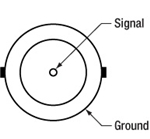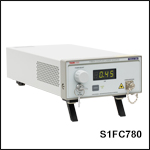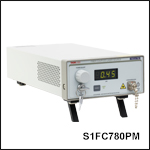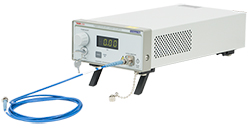Fiber-Coupled Laser Sources: NIR

- SM and PM Sources Available
- Minimum Full Output Powers from 1.5 to 25.0 mW
- Stable, Low Noise, Constant Power Operation
S1FC808
808 nm, 25.0 mW
Front Panel Display Provides an Enable Button, Laser Power Control, and Display Screen

Please Wait
| Single Channel Benchtop Laser Sources Selection Guide | |||||
|---|---|---|---|---|---|
| Spectrum | Wavelength | TEC | Laser Type | Cavity Type | Output Fiber Type |
| Visible | 405 - 675 nm | No | Semiconductor | Fabry Perot | SM, MM, or PM |
| 405 - 685 nm | Yes | Semiconductor | Fabry Perot | SM | |
| NIR | 785 - 1550 nm | No | Semiconductor | Fabry Perot | SM or PM |
| 705 - 2000 nm | Yes | Semiconductor | Fabry Perot | SM | |
| 1310 - 1550 nm | Yes | Semiconductor | DFB | SM | |
| 1900 - 2000 nm | N/A | Fiber Laser | Fabry Perot | SM | |
| MIR | 2.7 µm | N/A | Fiber Laser | Fabry Perot | SM |
| Other Fiber-Coupled Laser Sources | |||||
Features
- SM and PM Available Wavelengths: 785 to 1550 nm
- Single Mode or Multimode FC/PC Fiber Interface
- Stable, Low Noise, Constant Power Operation
- Power Level is Adjustable via Knob and BNC Modulation Input
- Interlock Circuit Provided via 2.5 mm Mono Jack
Thorlabs offers single mode and polarization-maintaining fiber-coupled laser sources that emit in the NIR portion of the spectrum. Each benchtop laser source features both a pigtailed Fabry-Perot laser diode and current controller in a single unit.
The front panel of each laser source displays the output power in mW, an on/off key, an enable button, and a knob to adjust the laser power. The back panel includes a BNC input that allows the laser diode drive current to be controlled via an external DC or sine wave voltage source and a remote interlock input.
Please refer to the table to the right for all of our single channel benchtop laser sources.
| Single Mode Source Specifications | ||||||||
|---|---|---|---|---|---|---|---|---|
| Item # | S1FC780 | S1FC785 | S1FC808 | S1FC980 | S1FC1060 | S1FC1550 | ||
| Wavelength | Minimum | 775 nm | 775 nm | 798 nm | 970 nm | 1054 nm | 1530 nm | |
| Typical | 785 nm | 785 nm | 808 nm | 980 nm | 1064 nm | 1550 nm | ||
| Maximum | 795 nm | 795 nm | 818 nm | 990 nm | 1074 nm | 1570 nm | ||
| Spectruma | ||||||||
| Minimum Full Output Power | 10.0 mW | 20.0 mW | 25.0 mW | 13.0 mW | 20.0 mW | 1.5 mW | ||
| Setpoint Resolution | 0.01 mW | 0.1 mW | 0.1 mW | 0.01 mW | 0.1 mW | 0.01 mW | ||
| Laser Class | 3B | 3B | 3B | 3B | 3B | 1 | ||
| Fiber | ||||||||
| Fiber Type | 780HP | 780HP | SM800-5.6-125 | SM980-5.8-125 | HI1060-J9 | SMF-28-J9 | ||
| Mode Field Diameterb | 4.7 - 6.9 µm @ 830 nm | 5.0 ± 0.5 µm @ 850 nm |
4.7 - 6.9 µm @ 830 nm | 5.3 - 6.4 µm @ 980 nm | 6.2 ± 0.3 µm @ 1060 nm | 10.4 ± 0.5 µm @ 1550 nm | ||
| Numerical Aperture | 0.10 - 0.14 | 0.13 | 0.10 - 0.14 | 0.13 - 0.15 | 0.14 | 0.14 | ||
| Output Fiber Connector | FC/PC, Wide 2.1 mm Key Compatible | |||||||
| Fiber | ||||||||
| Power Stability | 15 min: ±0.05 dB, 24 hr: ±0.1 dB (After 1 hr Warm-up at 25 ± 10 °C Ambient) |
|||||||
| Display Accuracy | ±10% | |||||||
| Adjustment Range | ~0 mW to Full Power | |||||||
| Input Power | 115 VAC / 230 VAC (Switch Selectable) 50 - 60 Hz | |||||||
| Modulation Input | 0 - 5 V = 0 - Full Power, DC or Sine Wave Input Only | |||||||
| Modulation Bandwidth | 5 kHz Full Depth of Modulation 30 kHz Small Signal Modulation |
|||||||
| Environmental | ||||||||
| Operating Temperature | 15 to 35 °C | |||||||
| Storage Temperature | 0 to 50 °C | |||||||
| Polarization-Maintaining Source Specifications | ||||
|---|---|---|---|---|
| Item # | S1FC780PM | S1FC1310PM | S1FC1550PM | |
| Wavelengtha | 785 nm | 1310 nm | 1550 nm | |
| Minimum Full Output Power | 6.25 mW | 1.5 mW | 1.5 mW | |
| Extinction Ratioa | >20 dB | >23 dB | >23 dB | |
| Stability | 15 min: ±0.05 dB, 24 hr:±0.1 dB (After 1 hr Warm-up at 25 ± 10 °C Ambient) |
|||
| Display Accuracy | ±10% | |||
| Setpoint Resolution | 0.01 mW | |||
| Laser Class | 3B | 1 | ||
| AdjustmentRange | ~0 mW to Full Power | |||
| Environmental | ||||
| Operating Temperature | 15 to 35 °C | |||
| Storage Temperature | 0 to 50 °C | |||
| AC Input | 115 VAC / 230 VAC (Switch Selectable) 50 - 60 Hz | |||
| Modulation Input | 0 - 5 V = 0 - Full Power, DC or Sine Wave Input Only | |||
| Modulation Bandwidth | 5 kHz Full Depth of Modulation 30 kHz Small Signal Modulation |
|||
| Fiber | PM780-HP | PM1300-HP | PM1550-HP | |
Modulation In
BNC Female

0 to 5 V Max, 50 Ω
Remote Interlock Input
2.5 mm Mono Phono Jack

Terminals must be shorted either by included plug or user device, i.e. external switch, for laser mode "ON" to be enabled.
| Posted Comments: | |
Rawan Semaan
(posted 2023-02-22 22:43:54.09) Hello,
I am interested in the Fiber-Coupled Laser Sources: NIR with 980 nm wavelength.
it stated that the Minimum Full Output Power is 13.0 mW. What is the maximum power?
Does this laser have internal modulation or do we need to modulate it externally?
Best regards,
Rawan ksosnowski
(posted 2023-03-08 01:51:51.0) Hello Rawan, thanks for reaching out to Thorlabs. For S1FC980, we guarantee at least a full output power of 13.0mW or more, typically the max full output can be a little higher than this, though it varies slightly between units. The unit can be tuned from 0mW to max output. The power can be adjusted from 0mW to the full output power, using either the control knob or the analog modulation port. This laser does not have an internal frequency generator, but you can apply external DC or sine signals up to 5kHz to modulate the output. I've reached out directly to discuss this application further. Ben Garber
(posted 2020-06-26 19:35:43.303) I was wondering what constitutes small-signal for the modulation bandwidth of the S1FC980. Specifically, for sine wave modulation, what kind of depth could we expect at 15kHz? asundararaj
(posted 2020-07-07 04:41:55.0) Thank you for contacting Thorlabs. The small signal modulation amplitude is about 100 mV at 30 kHz, which is about a 2% modulation depth. I have contacted you directly about the performance at 15 kHz. |

- Six Wavelengths Available: 785 to 1550 nm
- Minimum Full Output Powers of Up to 25.0 mW
- Fiber Patch Cables Sold Separately
These Single Mode Fiber-Coupled Laser Sources conveniently package a pigtailed Fabry-Perot laser diode and current controller into a single benchtop unit. The Fabry-Perot laser diode inside each unit is pigtailed to a single mode fiber that is terminated at an FC/PC bulkhead (wide and narrow key compatible) attached to the front panel of the unit. Thorlabs offers single mode fiber optic patch cables for connecting to the bulkhead on the front panel. To minimize losses, we recommend using a fiber patch cable that is the same fiber type as the fiber-pigtailed laser; refer to the Specs tab for the internal fiber type used for the pigtail. Additionally, to reduce noise from back reflections, we recommend that a hybrid FC/PC to FC/APC cable be used with the FC/PC end connected to the laser source.
Also found on the front panel is a display that shows the output power in mW, an on/off key, an enable button, and a knob to adjust the laser power. The back panel includes an input that allows the laser diode drive current to be controlled via an external DC or sine wave voltage source and a remote interlock input.
Note: The laser must be off when connecting or disconnecting fibers from the device, particularly for power levels above 10 mW.

- Three Wavelengths Available: 785 nm, 1310 nm, and 1550 nm
- Minimum Full Output Powers of Up to 6.25 mW
- Fiber Patch Cables Sold Separately
- Slow Axis of the PM Fiber Aligned to the Narrow Key of the FC/PC Bulkhead Connector
These Polarization-Maintaining Fiber-Coupled Laser Sources package a pigtailed Fabry-Perot laser diode inside each benchtop unit. The laser diode is pigtailed to a single mode PM fiber that is terminated at an FC/PC bulkhead attached to the front panel of the unit. During the pigtailing process, the fiber alignment is actively maintained so that the polarization axis of the laser diode is aligned with the slow-axis of the PM fiber. In addition, the slow-axis of the PM fiber is aligned to the narrow key of the FC/PC bulkhead connector on the front panel of the benchtop unit. Thorlabs offers polarization-maintaining fiber optic patch cables for connecting to the bulkhead on the front panel. To minimize losses, we recommend using a fiber patch cable that is the same fiber type as the fiber-pigtailed laser; refer to the Specs tab for the internal fiber type used for the pigtail. Additionally, to reduce noise from back reflections, we recommend that a hybrid FC/PC to FC/APC cable be used with the FC/PC end connected to the laser source.
Also found on the front panel is a display that shows the output power in mW, an on / off key, an enable button, and a knob to adjust the laser power. The back panel includes an input that allows the laser diode drive current to be controlled via an external voltage source and a remote interlock input.
Note: The laser must be off when connecting or disconnecting fibers from the device.
 Products Home
Products Home


















 Zoom
Zoom

 Fabry-Perot Laser Sources
Fabry-Perot Laser Sources